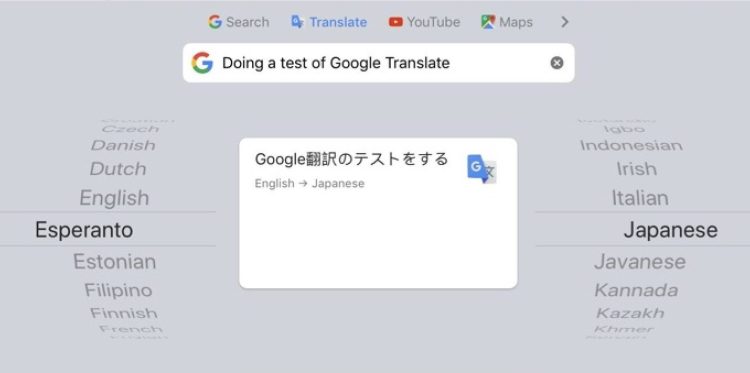testsetset
Google and Microsoft’s software releases may grab the attention of Android and Windows users, but on Apple’s iOS platform, even major app updates are easy to miss. Whether small or large, App Store developers get roughly 15 words on an iPhone and 30 words on an iPad to describe an update’s new features before “more” buttons hide the details away. Since so many apps are updated weekly or bi-weekly, users often see long lists of updates — if they look at all — and nothing really stands out anymore.
On a rare occasion, something big slips into an app update, and the question — for both developers and journalists — is whether people will notice or care. That’s happened twice over the last two weeks, as Google and Microsoft added big automatic translation features to apps that iOS users might not previously have cared about. Their mission is clear: Leverage the convenience of machine translation to win people over from Apple’s stock apps.
Yesterday, Google updated the iOS version of its Gboard – the Google Keyboard app to include automatic language translation, a change Android users noted was roughly two years behind their platform. Gboard now lets users of any iOS app (including popular stock apps such as Messages and Mail) instantly convert typed phrases or sentences between upwards of 50 languages supported by Google Translate.
This is a big win for iOS users. Since no iPhone supports displaying two apps at once, users interested in translating what they were typing in Messages have generally had to switch between apps, though iPad users with split-screen mode could awkwardly run Google Translate on one side of the screen and Messages on the other.
June 5th: The AI Audit in NYC
Join us next week in NYC to engage with top executive leaders, delving into strategies for auditing AI models to ensure fairness, optimal performance, and ethical compliance across diverse organizations. Secure your attendance for this exclusive invite-only event.
Believe it or not, many — perhaps even most — iOS users have no idea that Apple’s keyboard is basically just another stock app they can switch away from, even though third-party keyboards have been an Android feature since the early days. Apple only added third-party keyboard support with the release of iOS 8 in late 2014, and the company still puts up a warning dialog box when you try to provide “full access” to a keyboard.

It’s easy to trigger iOS users with “look out!” privacy warnings. Apple has spent years questioning the implications of trusting personal information to developers — at one point explicitly including Google. In recent months, the privacy campaign has moved into more aggressive pitches on YouTube, the sides of buildings, and the company’s own website.
Will anyone happily switch keyboards after reading iOS’ warning that third-party keyboard developers can “transmit anything you type” and have “previously typed,” including “sensitive information such as your credit card number or street address”? That may well be true, and since users can’t see what’s actually being transmitted to developers, many may steer clear of third-party keyboards.
On the other hand, Apple hasn’t developed rival services to match what Google is offering — and that’s true across many of Google’s machine learning-assisted initiatives. As time goes on and Apple’s solutions continue to fall short of Google’s, iOS users look at these features and ask whether they warrant switching platforms … or just core apps. So even though alternate keyboards haven’t really taken off on iOS, ML-aided conveniences like this make anything possible.
Google’s not the only company using automatic language translation to win iOS users away from Apple’s own apps. Less than two weeks ago, Microsoft released an iOS update to its Edge browser that offers instant translation of foreign-language websites visited by the user.

Above: Microsoft’s Edge browser for iOS added automatic machine translation of websites that’s great — when it works.
On the newsworthiness scale, the Edge update ranks even lower than the Gboard update: Microsoft has bundled a Safari language translation plug-in for years with the iOS Bing app, and Google’s iOS Chrome browser already had a one-tap translation feature for foreign-language sites. Moreover, Edge’s translator is neither the first nor always the best. When it works, it translates the page automatically, but when it doesn’t Edge won’t even display a button to allow manual translation.
Compare the Edge foreign-language experience with Apple’s own Safari browser, however, and you’ll have a sense of why some users might want to shift away from Apple’s integrated app. Apple doesn’t include any translation option within Safari, and — as with third-party keyboards — users might not realize that third-party “Action extensions” for Safari have been available since iOS 8. There’s no specific Safari extension app store for iOS, so while the feature is there, it’s largely under the radar.
Even assuming you’re willing to download Microsoft’s Bing to use the translation Action extension for Safari, that’s at least two extra taps every time you want to translate a page. With Edge, frequent second-language readers don’t have to tap anything; it’s all handled in the background. Machine learning enables both the discovery of foreign language pages and their translation into something you can read.
Since neither Edge nor Gboard has proved particularly popular on iOS in the past, it’s easy to write off each of these updates as small news. But the bigger story is that instant language translation is — belatedly — becoming considerably more convenient for iOS users, in part thanks to machine learning. If Apple doesn’t build its own solutions — something that should be well within its capabilities — it could start losing both keyboard users and browser share to two of its biggest and most aggressive competitors.

